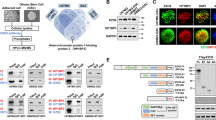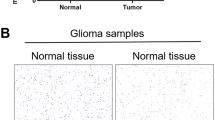Abstract
The tripartite motif protein TRIM24 (tripartite motif-containing 24) has been found to play distinct roles in tumor development and progression, according to different tumor contexts. However, it remains elusive whether TRIM24 plays a role in malignant gliomas that are the most common and deadly primary brain tumors in adults. We report here that TRIM24 expression is positively correlated with glioma malignancy and is negatively associated with prognosis of patients with newly diagnosed glioblastoma, which is the most malignant form of gliomas but displays highly heterogeneous clinical outcome. The multivariate Cox regression analysis demonstrates the independent predictive value of TRIM24 expression level for overall and progression-free survival. Knockdown of TRIM24 suppresses cell proliferation, cell cycle progression, clone formation and in vivo tumor development, whereas overexpression of TRIM24 promotes cell growth. Chromatin immunoprecipitation, real-time reverse transcription–PCR and mutation analyses demonstrate that TRIM24 binds to the PIK3CA promoter via its PHD–Bromo domain to activate the transcription of PIK3CA gene, thus enhancing phosphatidylinositide 3-kinase (PI3K)/Akt signaling. The pan-PI3K inhibitor LY294002 and small interfering RNA targeting PIK3CA both abrogate the growth-promoting effect of TRIM24. Moreover, TRIM24 regulates the expression of DNA repair enzyme O6-methylguanine-DNA methyltransferase (MGMT) through PI3K/Akt/nuclear factor-κB signaling transduction and enhances resistance to temozolomide, the standard chemotherapeutic agent for glioblastoma. Finally, glioblastoma patients with low TRIM24 expression benefit from chemotherapy, whereas those with high TRIM24 expression do not have such benefit. Our results suggest that TRIM24 might serve as a potential prognostic marker and therapeutic target for the management of malignant gliomas.
This is a preview of subscription content, access via your institution
Access options
Subscribe to this journal
Receive 50 print issues and online access
$259.00 per year
only $5.18 per issue
Buy this article
- Purchase on Springer Link
- Instant access to full article PDF
Prices may be subject to local taxes which are calculated during checkout







Similar content being viewed by others
References
Dolecek TA, Propp JM, Stroup NE, Kruchko C . CBTRUS statistical report: primary brain and central nervous system tumors diagnosed in the United States in 2005-2009. Neuro Oncol 2012; 14 (Suppl 5): v1–49.
Wen PY, Kesari S . Malignant gliomas in adults. N Engl J Med 2008; 359: 492–507.
Herquel B, Ouararhni K, Davidson I . The TIF1alpha-related TRIM cofactors couple chromatin modifications to transcriptional regulation, signaling and tumor suppression. Transcription 2011; 2: 231–236.
Hatakeyama S . TRIM proteins and cancer. Nat Rev Cancer 2011; 11: 792–804.
Herquel B, Ouararhni K, Khetchoumian K, Ignat M, Teletin M, Mark M et al. Transcription cofactors TRIM24, TRIM28, and TRIM33 associate to form regulatory complexes that suppress murine hepatocellular carcinoma. Proc Natl Acad Sci USA 2011; 108: 8212–8217.
Allton K, Jain AK, Herz HM, Tsai WW, Jung SY, Qin J et al. Trim24 targets endogenous p53 for degradation. Proc Natl Acad Sci USA 2009; 106: 11612–11616.
Jain AK, Barton MC . Regulation of p53: TRIM24 enters the RING. Cell Cycle 2009; 8: 3668–3674.
Khetchoumian K, Teletin M, Tisserand J, Mark M, Herquel B, Ignat M et al. Loss of Trim24 (Tif1alpha) gene function confers oncogenic activity to retinoic acid receptor alpha. Nat Genet 2007; 39: 1500–1506.
Ou HD, Kwiatkowski W, Deerinck TJ, Noske A, Blain KY, Land HS et al. A structural basis for the assembly and functions of a viral polymer that inactivates multiple tumor suppressors. Cell 2012; 151: 304–319.
Gandini D, De Angeli C, Aguiari G, Manzati E, Lanza F, Pandolfi PP et al. Preferential expression of the transcription coactivator HTIF1alpha gene in acute myeloid leukemia and MDS-related AML. Leukemia 2002; 16: 886–893.
Quintas-Cardama A, Qiu YH, Post SM, Zhang Y, Creighton CJ, Cortes J et al. Reverse phase protein array profiling reveals distinct proteomic signatures associated with chronic myeloid leukemia progression and with chronic phase in the CD34-positive compartment. Cancer 2012; 118: 5283–5292.
Tsai WW, Wang Z, Yiu TT, Akdemir KC, Xia W, Winter S et al. TRIM24 links a non-canonical histone signature to breast cancer. Nature 2010; 468: 927–932.
Chambon M, Orsetti B, Berthe ML, Bascoul-Mollevi C, Rodriguez C, Duong V et al. Prognostic significance of TRIM24/TIF-1alpha gene expression in breast cancer. Am J Pathol 2011; 178: 1461–1469.
The Cancer Genome Atlas Research Network, Comprehensive genomic characterization defines human glioblastoma genes and core pathways. Nature 2008; 455: 1061–1068.
Worster DT, Schmelzle T, Solimini NL, Lightcap ES, Millard B, Mills GB et al. Akt and ERK control the proliferative response of mammary epithelial cells to the growth factors IGF-1 and EGF through the cell cycle inhibitor p57Kip2. Sci Signal 2012; 5: ra19.
Chowdhry S, Zhang Y, McMahon M, Sutherland C, Cuadrado A, Hayes JD . Nrf2 is controlled by two distinct beta-TrCP recognition motifs in its Neh6 domain, one of which can be modulated by GSK-3 activity. Oncogene 2013; 32: 3765–3781.
Hui RC, Gomes AR, Constantinidou D, Costa JR, Karadedou CT, Fernandez de Mattos S et al. The forkhead transcription factor FOXO3a increases phosphoinositide-3 kinase/Akt activity in drug-resistant leukemic cells through induction of PIK3CA expression. Mol Cell Biol 2008; 28: 5886–5898.
Ikegami D, Akiyama H, Suzuki A, Nakamura T, Nakano T, Yoshikawa H et al. Sox9 sustains chondrocyte survival and hypertrophy in part through Pik3ca-Akt pathways. Development 2011; 138: 1507–1519.
Hegi ME, Diserens AC, Gorlia T, Hamou MF, de Tribolet N, Weller M et al. MGMT gene silencing and benefit from temozolomide in glioblastoma. N Engl J Med 2005; 352: 997–1003.
Danam RP, Howell SR, Brent TP, Harris LC . Epigenetic regulation of O6-methylguanine-DNA methyltransferase gene expression by histone acetylation and methyl-CpG binding proteins. Mol Cancer Ther 2005; 4: 61–69.
Tolcher AW, Gerson SL, Denis L, Geyer C, Hammond LA, Patnaik A et al. Marked inactivation of O6-alkylguanine-DNA alkyltransferase activity with protracted temozolomide schedules. Br J Cancer 2003; 88: 1004–1011.
Van Meir EG, Hadjipanayis CG, Norden AD, Shu HK, Wen PY, Olson JJ . Exciting new advances in neuro-oncology: the avenue to a cure for malignant glioma. CA Cancer J Clin 2010; 60: 166–193.
Chen J, McKay RM, Parada LF . Malignant glioma: lessons from genomics, mouse models, and stem cells. Cell 2012; 149: 36–47.
Kikuchi M, Okumura F, Tsukiyama T, Watanabe M, Miyajima N, Tanaka J et al. TRIM24 mediates ligand-dependent activation of androgen receptor and is repressed by a bromodomain-containing protein, BRD7, in prostate cancer cells. Biochim Biophys Acta 2009; 1793: 1828–1836.
Herquel B, Ouararhni K, Martianov I, Le Gras S, Ye T, Keime C et al. Trim24-repressed VL30 retrotransposons regulate gene expression by producing noncoding RNA. Nat Struct Mol Biol 2013; 20: 339–346.
Tisserand J, Khetchoumian K, Thibault C, Dembele D, Chambon P, Losson R . Tripartite motif 24 (Trim24/Tif1alpha) tumor suppressor protein is a novel negative regulator of interferon (IFN)/signal transducers and activators of transcription (STAT) signaling pathway acting through retinoic acid receptor alpha (Raralpha) inhibition. J Biol Chem 2011; 286: 33369–33379.
Josset L, Belser JA, Pantin-Jackwood MJ, Chang JH, Chang ST, Belisle SE et al. Implication of inflammatory macrophages, nuclear receptors, and interferon regulatory factors in increased virulence of pandemic 2009 H1N1 influenza A virus after host adaptation. J Virol 2012; 86: 7192–7206.
Ignat M, Teletin M, Tisserand J, Khetchoumian K, Dennefeld C, Chambon P et al. Arterial calcifications and increased expression of vitamin D receptor targets in mice lacking TIF1alpha. Proc Natl Acad Sci USA 2008; 105: 2598–2603.
Ledda-Columbano GM, Pibiri M, Molotzu F, Cossu C, Sanna L, Simbula G et al. Induction of hepatocyte proliferation by retinoic acid. Carcinogenesis 2004; 25: 2061–2066.
Barbus S, Tews B, Karra D, Hahn M, Radlwimmer B, Delhomme N et al. Differential retinoic acid signaling in tumors of long- and short-term glioblastoma survivors. J Natl Cancer Inst 2011; 103: 598–606.
Jain AK, Allton K, Iacovino M, Mahen E, Milczarek RJ, Zwaka TP et al. p53 regulates cell cycle and microRNAs to promote differentiation of human embryonic stem cells. PLoS Biol 2012; 10: e1001268.
Terzian T, Suh YA, Iwakuma T, Post SM, Neumann M, Lang GA et al. The inherent instability of mutant p53 is alleviated by Mdm2 or p16INK4a loss. Genes Dev 2008; 22: 1337–1344.
Li H, Sun L, Tang Z, Fu L, Xu Y, Li Z et al. Overexpression of TRIM24 correlates with tumor progression in non-small cell lung cancer. PLoS One 2012; 7: e37657.
Aghi M, Visted T, Depinho RA, Chiocca EA . Oncolytic herpes virus with defective ICP6 specifically replicates in quiescent cells with homozygous genetic mutations in p16. Oncogene 2008; 27: 4249–4254.
Kanai R, Rabkin SD, Yip S, Sgubin D, Zaupa CM, Hirose Y et al. Oncolytic virus-mediated manipulation of DNA damage responses: synergy with chemotherapy in killing glioblastoma stem cells. J Natl Cancer Inst 2012; 104: 42–55.
Manning BD, Cantley LC . AKT/PKB signaling: navigating downstream. Cell 2007; 129: 1261–1274.
Vassilev LT, Vu BT, Graves B, Carvajal D, Podlaski F, Filipovic Z et al. In vivo activation of the p53 pathway by small-molecule antagonists of MDM2. Science 2004; 303: 844–848.
Fritsch R, de Krijger I, Fritsch K, George R, Reason B, Kumar MS et al. RAS and RHO families of GTPases directly regulate distinct phosphoinositide 3-kinase isoforms. Cell 2013; 153: 1050–1063.
Kaina B, Christmann M, Naumann S, Roos WP . MGMT: key node in the battle against genotoxicity, carcinogenicity and apoptosis induced by alkylating agents. DNA Repair (Amst) 2007; 6: 1079–1099.
Louis DN, Ohgaki H, Wiestler OD, Cavenee WK, Burger PC, Jouvet A et al. The 2007 WHO classification of tumours of the central nervous system. Acta Neuropathol 2007; 114: 97–109.
Aghi M, Rabkin S, Martuza RL . Effect of chemotherapy-induced DNA repair on oncolytic herpes simplex viral replication. J Natl Cancer Inst 2006; 98: 38–50.
Acknowledgements
We thank Xiao-Liang Yang, Xi-Qiang Cai and Juan Li for helpful assistance. This work was supported by the National Natural Science Foundation of China (no. 30870843 and no. 81171087) to X Zhang. The funding body does not play any role in the design of the study, collection and analysis of data and decision to publish.
Author information
Authors and Affiliations
Corresponding author
Ethics declarations
Competing interests
The authors declare no conflict of interest.
Additional information
Supplementary Information accompanies this paper on the Oncogene website
Rights and permissions
About this article
Cite this article
Zhang, LH., Yin, AA., Cheng, JX. et al. TRIM24 promotes glioma progression and enhances chemoresistance through activation of the PI3K/Akt signaling pathway. Oncogene 34, 600–610 (2015). https://doi.org/10.1038/onc.2013.593
Received:
Revised:
Accepted:
Published:
Issue Date:
DOI: https://doi.org/10.1038/onc.2013.593
Keywords
This article is cited by
-
MicroRNAs as the critical regulators of autophagy-mediated cisplatin response in tumor cells
Cancer Cell International (2023)
-
Targeting TRIM24 promotes neuroblastoma differentiation and decreases tumorigenicity via LSD1/CoREST complex
Cellular Oncology (2023)
-
TRIM family contribute to tumorigenesis, cancer development, and drug resistance
Experimental Hematology & Oncology (2022)
-
High expression of TRIM24 predicts worse prognosis and promotes proliferation and metastasis of epithelial ovarian cancer
Journal of Ovarian Research (2022)
-
TRIM24 is an insulin-responsive regulator of P-bodies
Nature Communications (2022)



